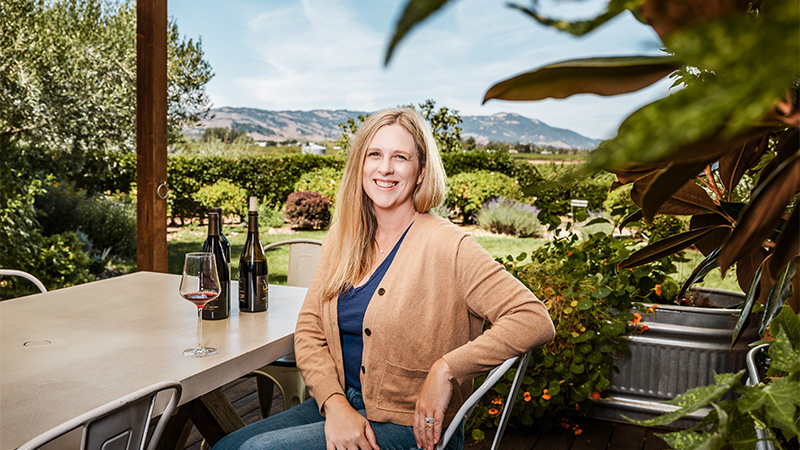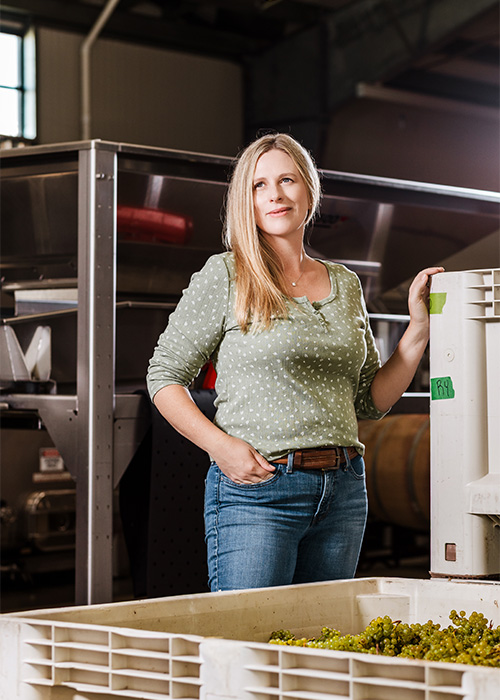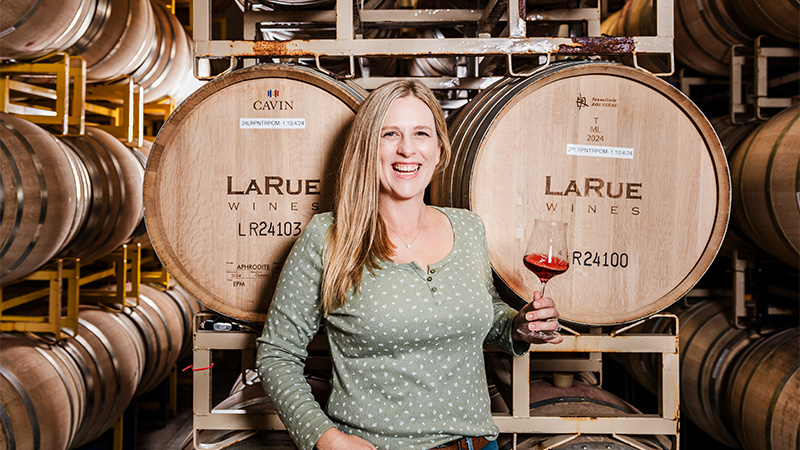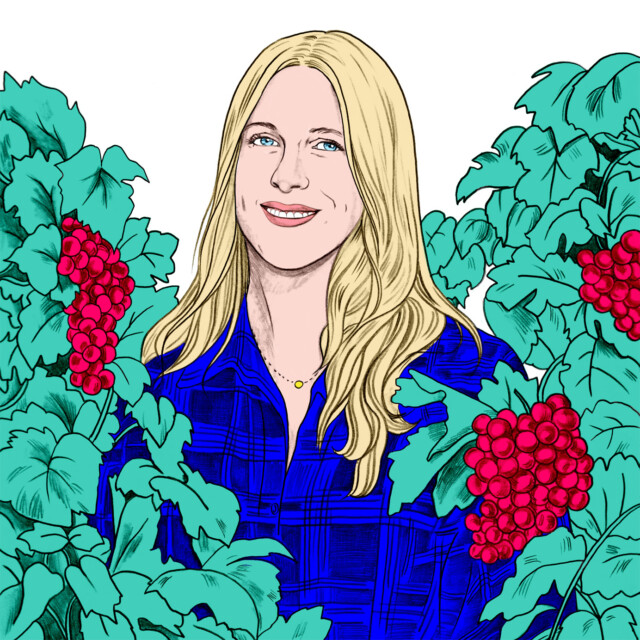When staring at a wall of labels in a wine shop, it’s not always immediately clear who exactly is behind the wine. But if you’re looking for a bottle of Sonoma Pinot Noir or Chardonnay, chances are pretty high that winemaker Katy Wilson had something to do with it.
With over 20 years of experience in viticulture and winemaking, Wilson is the muscle behind popular brands including Reeve, BloodRoot, Smith Story Wine Cellars, Anaba Wines, and her own personal label, LaRue Wines. She consults on and produces about 200 to 300 cuvées each vintage, working with approximately 30 different varieties each year, each sourced from distinct vineyard sites across Sonoma.
Wilson’s interest in agriculture started from a young age, growing up on a small, 15-acre walnut orchard in California’s Central Valley. “We did everything ourselves,” she says. “I grew up driving a tractor and working the orchards, planting the trees and pruning.” Wilson attended Cal Poly in San Luis Obispo to pursue a degree in agricultural business. She recalls learning about wine as a potential career opportunity early on, and immediately opted to add a second major in wine and viticulture.
Like many winemakers, Wilson was drawn to the discipline because of the unique opportunity to work with an agricultural product while adding a personal touch. “It’s not like growing walnuts where you don’t know where they go after you sell them,” she says. “You’re creating something after it’s done growing, and every year brings you something different.”
After graduating, Wilson started her first job in the industry, working on a 1,000-acre vineyard in the Central Valley. “I wanted to learn every part of what we do and what every aspect of winemaking entails,” she says. “You can’t ask someone to do something for you if you haven’t done it yourself. And this job really helped me get to know one of the hardest parts of the industry.”

Similar to many who catch the winemaking bug, Wilson started traversing hemispheres to work two harvests a year, gaining experience in Napa Valley, New Zealand, and Australia. In addition to seeing regions like Hawkes Bay and Barossa in person, she enjoyed meeting eager young winemakers from around the world, spending nights talking to people from Bordeaux and beyond to compare different methods and wine styles.
But when it came time to settle into one region, she felt drawn to the Sonoma Coast, and specifically to Pinot Noir. She worked as the assistant winemaker at the acclaimed Flowers Winery for several years, and left in 2009 to join Robert Kamen at Sonoma’s Kamen Wines. There, Kamen offered Wilson the opportunity to make her own wines in their production facility. And shortly after, esteemed wine grower Ross Cobb approached her with the offer to share fruit from the acclaimed Rice-Spivak Vineyard, a six- acre site just south of Sebastopol defined by its volcanic soils and thick layer of morning fog. Unsure of how to turn down such a compelling plot, Wilson started LaRue wines, named after her grandmother, with a small batch of Pinot Noir in 2009. Not one to idle, she started consulting for other ventures in 2012, helping with vineyard selection and winemaking. As her client list grew, Wilson eventually parted ways with Kamen, setting up shop at the new Anaba Wines facility in 2014 to help with their production, as well as focus on her many wine partners.
While LaRue might be her own personal project, Wilson is no less attentive when it comes to her clients, learning each of their styles and what they want from their wines. “I’m constantly talking to the owners of the wineries,” she says. “I know that John at Anaba doesn’t care for whole-cluster fermentation in Pinot Noir, but loves it in his Rhône varieties. Small things like that can really change how the wines come out.” Wilson’s ability to put aside her personal style and adapt to each winemaker’s preference — making compelling wines in drastically different styles concurrently — showcases her impressive skill.

She also works on the viticulture side for all the wines she makes, sourcing from about 40 different sites that she’s developed relationships with over time. She communicates with vineyard managers about farming and picking decisions, calling back to her roots in agriculture.
Beyond her clients’ wines, Wilson’s personal perspective on Pinot Noir and Chardonnay shines through in her LaRue bottlings. Though production has grown some over time, her goal has always been to keep LaRue a small selection of specialty vineyard sites with stunning quality.

Wilson’s dedication to crafting the best-quality wines in Sonoma sets a standard for the region, and she’s constantly working to improve vintage after vintage. This comes through in the site-driven wines of Reeve and BloodRoot, which she makes, now as director of winemaking, with longtime collaborators Noah and Kelly Dorrance. Reeve focuses on single-vineyard Pinot Noirs and Chardonnays from coveted sites across Sonoma. While its wines appeal to the seasoned wine drinker, the more approachable, price-competitive bottlings of BloodRoot have found a distinct level of success, showing that quality wines at a great value are what helps draw new customers in. And as the California wine industry continues to hit roadblocks, it’s more important than ever to have thoughtful winemakers who work with the future of the industry in mind.
Wilson’s work on both small and large scales, for both accessible and expensive wines, and fulfilling partnerships are a reflection of her relentless commitment to the craft. “For me it’s about constantly learning and adapting,” she says. “I can never get complacent, it’s not possible.”
